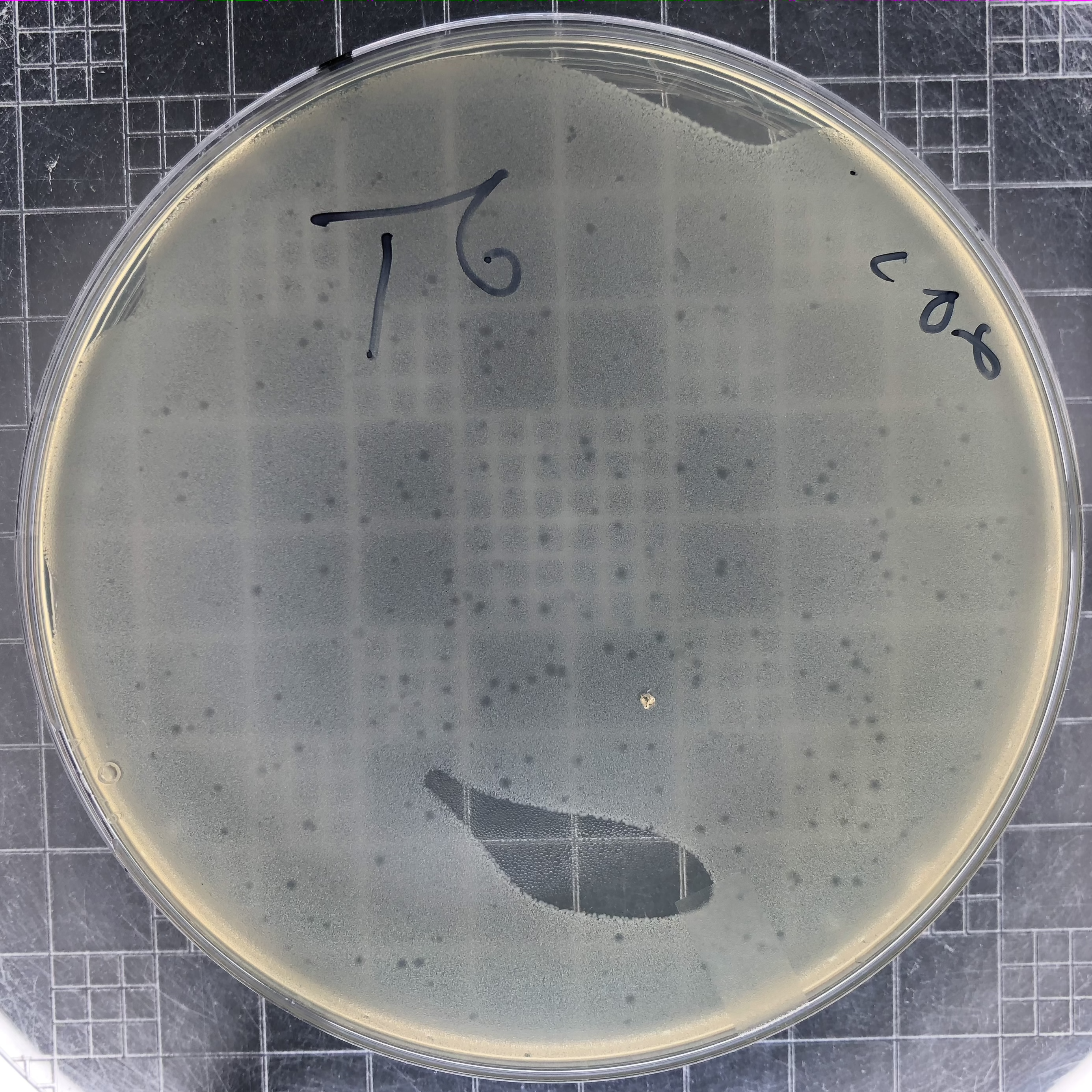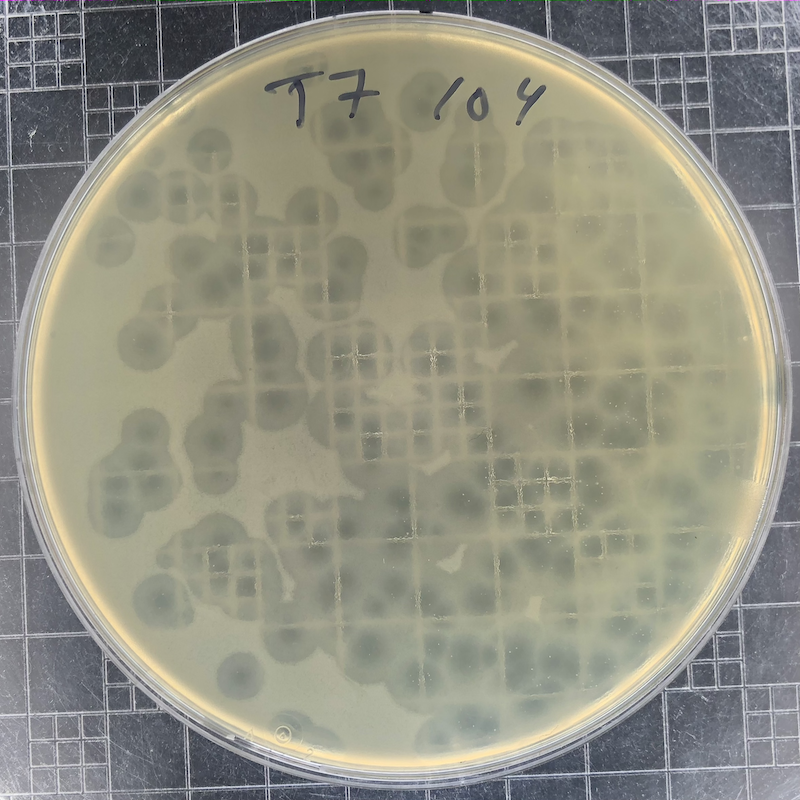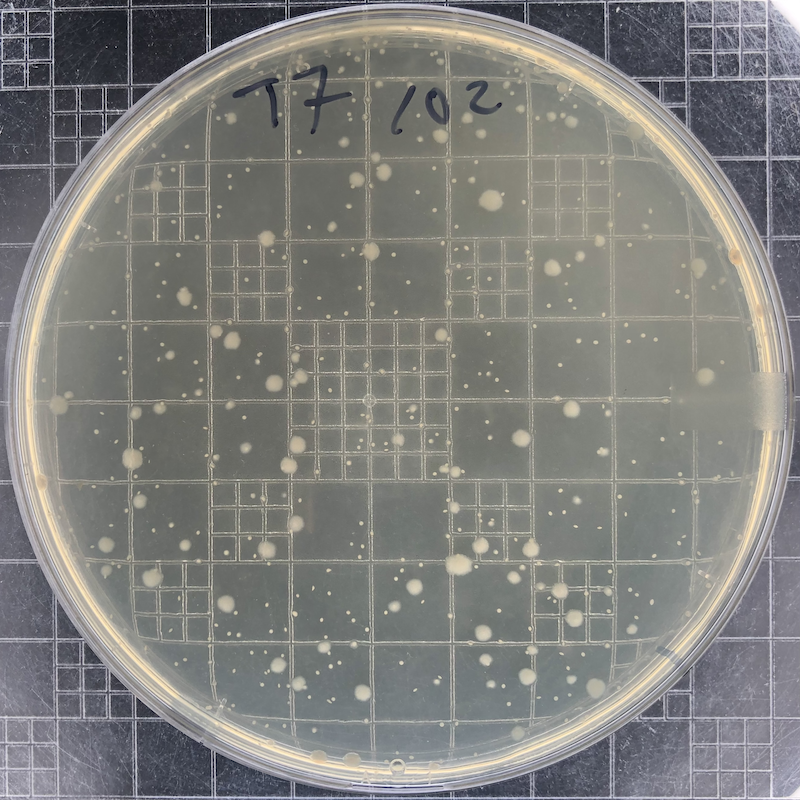
Difference: ProtocolsPhageTiters (1 vs. 6)
Revision 62020-12-03 - CameronRoots
Determining Phage Titer | ||||||||
| Added: | ||||||||
| > > | Phage Titering is a procedure used to quantify the density of plaque-forming units (PFU, analogous to a bacterial culture’s colony-forming units) in a given lysate. To achieve this, the researcher performing the experiment exposes exponentially growing bacteria to the bacteriophage of interest before allowing the bacteriophages to propagate overnight. | |||||||
Materials | ||||||||
| Changed: | ||||||||
| < < |
| |||||||
| > > |
| |||||||
| Added: | ||||||||
| > > | ||||||||
| ||||||||
| Added: | ||||||||
| > > |
| |||||||
| ||||||||
| Added: | ||||||||
| > > |
| |||||||
Procedure
| ||||||||
| Changed: | ||||||||
| < < |
| |||||||
| > > |
| |||||||
Expected Results
Troubleshooting
Example of Calculating Phage Titer | ||||||||
| Changed: | ||||||||
| < < | Since you are plating 100 µl of each stock you should multiply by 10 and also by the dilution of the tube that gave a countable number of plaques to determine the PFU/ml in the original lysate. So, if there were 25 plaques in the 100 µl you mixed in of the 106 dilution, then the lysate would have 2.5×108 PFU/ml. | |||||||
| > > | The final PFU count for each plate is n × 10 × d PFU/ml, where n is the number of plaques observed and d is the value from the dilution series. This is derived from the use of 0.1 ml of the phage stock to set up the initial dilutions. As an example, n=25 plaques on the d=106 dilution plate would represent 2.5×108 PFU/ml in the original lysis. | |||||||
| ||||||||
Revision 52020-02-26 - JeffreyBarrick
Determining Phage TiterMaterials
Procedure
Expected Results
| |||||||||
| Changed: | |||||||||
| < < | Tourbleshooting | ||||||||
| > > | Troubleshooting | ||||||||
Example of Calculating Phage TiterSince you are plating 100 µl of each stock you should multiply by 10 and also by the dilution of the tube that gave a countable number of plaques to determine the PFU/ml in the original lysate. So, if there were 25 plaques in the 100 µl you mixed in of the 106 dilution, then the lysate would have 2.5×108 PFU/ml.
| |||||||||
Revision 42020-02-25 - JeffreyBarrick
Determining Phage TiterMaterials
| ||||||||
| Changed: | ||||||||
| < < |
| |||||||
| > > |
| |||||||
Procedure | ||||||||
| Changed: | ||||||||
| < < |
| |||||||
| > > |
| |||||||
| Added: | ||||||||
| > > |
| |||||||
| ||||||||
| Changed: | ||||||||
| < < |
| |||||||
| > > |
| |||||||
| ||||||||
| Changed: | ||||||||
| < < |
| |||||||
| > > |
| |||||||
Expected Results | ||||||||
| Changed: | ||||||||
| < < |
| |||||||
| > > |
| |||||||
| ||||||||
| Added: | ||||||||
| > > | Tourbleshooting
| |||||||
Example of Calculating Phage TiterSince you are plating 100 µl of each stock you should multiply by 10 and also by the dilution of the tube that gave a countable number of plaques to determine the PFU/ml in the original lysate. So, if there were 25 plaques in the 100 µl you mixed in of the 106 dilution, then the lysate would have 2.5×108 PFU/ml. | ||||||||
| Changed: | ||||||||
| < < |
| |||||||
| > > |
| |||||||
Revision 32020-02-24 - JeffreyBarrick
Determining Phage TiterMaterials
Procedure
| ||||||||
| Added: | ||||||||
| > > | Expected Results
| |||||||
Example of Calculating Phage TiterSince you are plating 100 µl of each stock you should multiply by 10 and also by the dilution of the tube that gave a countable number of plaques to determine the PFU/ml in the original lysate. So, if there were 25 plaques in the 100 µl you mixed in of the 106 dilution, then the lysate would have 2.5×108 PFU/ml. | ||||||||
| Added: | ||||||||
| > > |
| |||||||
Revision 22020-02-23 - JeffreyBarrick
Determining Phage Titer | ||||||||
| Changed: | ||||||||
| < < |
| |||||||
| > > | Materials
| |||||||
| Added: | ||||||||
| > > |
| |||||||
| Changed: | ||||||||
| < < | -- Main.ColinBrown - 14 Dec 2017 | |||||||
| > > | Procedure | |||||||
| Added: | ||||||||
| > > |
Example of Calculating Phage TiterSince you are plating 100 µl of each stock you should multiply by 10 and also by the dilution of the tube that gave a countable number of plaques to determine the PFU/ml in the original lysate. So, if there were 25 plaques in the 100 µl you mixed in of the 106 dilution, then the lysate would have 2.5×108 PFU/ml. | |||||||
Revision 12017-12-14 - ColinBrown
View topic | History: r6 < r5 < r4 < r3 | More topic actions...


